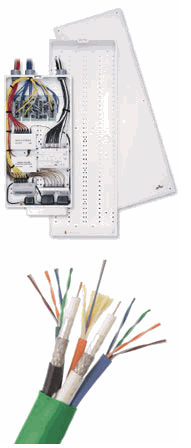Structured wiring provides a central point of connection to incoming signals for all low voltage wire runs.
This is a relatively new method of wiring.
Previously, all low voltage wiring ran in a loop, running from the first termination point to the second point, from the second to the third and so on.
In structured wiring all wires run from a central location to its planned termination (outlet) point.

Figure 1 - Structured wiring cable
The advantages to a structured wiring methodology are:
- If a wire becomes damaged you only loose signal to that point of termination. In the loop method you loose all terminations from the damaged section onward.
- In a loop configuration you cannot make changes to what signal is fed to a termination point, because it is a loop, the last termination point must have the same signal as the first termination point. In a structured system, you have the flexibility to change the signal content of each and every wire going to each and every termination point.
Many manufacturers are now producing special panels and termination strips for structured wiring systems. These panels include options of amplifiers, switched termination strips, low voltage power and multiplexers. The systems are designed to grow with the occupant and can be easily expanded and reconfigured depending on your needs now and in the future.
Although there is increased initial cost, the amount of wire used and added time in running all wires back to a central point, the expense is well worth it. It may be noted that structured wiring systems have been a strong selling feature in resale homes and are a definitely a differentiator for the buyer.
Although wireless connections are becoming common many homes face connection problems and interference using wireless technology.
A hard wired system is much more reliable network than a wireless system.
Additional information and installation techniques for structured wiring.
